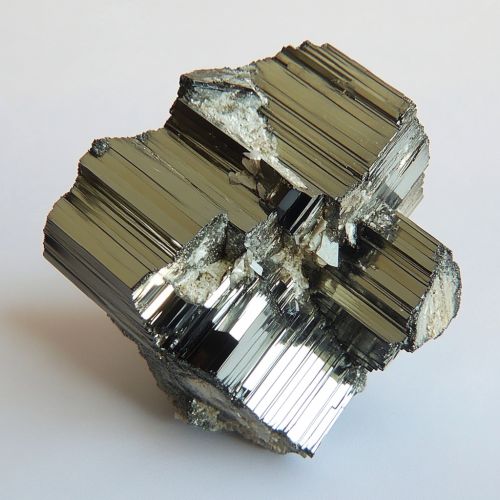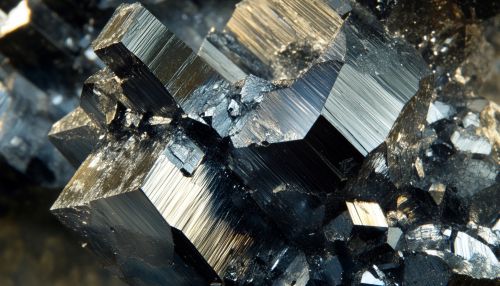Tantalum arsenide: Difference between revisions
(Created page with "== Introduction == Tantalum arsenide (TaAs) is a compound of tantalum and arsenic. It is a member of a family of compounds known as transition metal monopnictides, which are characterized by the combination of a transition metal with a group V element. TaAs has garnered significant interest in the fields of condensed matter physics and materials science due to its unique electronic properties, particularly its status as a Weyl semimetal. This article provides a comprehe...") |
No edit summary |
||
| Line 11: | Line 11: | ||
The crystal structure of TaAs can be described using space group I41md. The lattice parameters are approximately a = 3.437 Å and c = 11.656 Å. The structure consists of alternating layers of tantalum and arsenic atoms, which contribute to its unique electronic properties. The bonding within the layers is primarily covalent, with some degree of ionic character due to the difference in electronegativity between tantalum and arsenic. | The crystal structure of TaAs can be described using space group I41md. The lattice parameters are approximately a = 3.437 Å and c = 11.656 Å. The structure consists of alternating layers of tantalum and arsenic atoms, which contribute to its unique electronic properties. The bonding within the layers is primarily covalent, with some degree of ionic character due to the difference in electronegativity between tantalum and arsenic. | ||
[[Image:Detail-98023.jpg|thumb|center|Crystalline structure of tantalum arsenide, showing alternating layers of tantalum and arsenic atoms.|class=only_on_mobile]] | |||
[[Image:Detail-98024.jpg|thumb|center|Crystalline structure of tantalum arsenide, showing alternating layers of tantalum and arsenic atoms.|class=only_on_desktop]] | |||
== Physical Properties == | == Physical Properties == | ||
Latest revision as of 05:25, 20 September 2024
Introduction
Tantalum arsenide (TaAs) is a compound of tantalum and arsenic. It is a member of a family of compounds known as transition metal monopnictides, which are characterized by the combination of a transition metal with a group V element. TaAs has garnered significant interest in the fields of condensed matter physics and materials science due to its unique electronic properties, particularly its status as a Weyl semimetal. This article provides a comprehensive overview of the chemical, physical, and electronic properties of tantalum arsenide, as well as its synthesis methods, applications, and significance in scientific research.
Chemical Properties
Tantalum arsenide is a binary compound consisting of tantalum (Ta) and arsenic (As). The chemical formula is TaAs. It crystallizes in a body-centered tetragonal structure, which is a common feature among transition metal monopnictides. The compound is known for its high melting point and chemical stability.
Composition and Structure
The crystal structure of TaAs can be described using space group I41md. The lattice parameters are approximately a = 3.437 Å and c = 11.656 Å. The structure consists of alternating layers of tantalum and arsenic atoms, which contribute to its unique electronic properties. The bonding within the layers is primarily covalent, with some degree of ionic character due to the difference in electronegativity between tantalum and arsenic.


Physical Properties
Tantalum arsenide exhibits several notable physical properties, including high electrical conductivity, thermal stability, and mechanical hardness. These properties make it suitable for various industrial and technological applications.
Electrical Conductivity
One of the most significant properties of TaAs is its high electrical conductivity. This is attributed to its unique electronic band structure, which features Weyl fermions. Weyl fermions are massless quasiparticles that arise in certain types of semimetals, leading to high mobility and conductivity. The presence of Weyl nodes in the electronic band structure of TaAs results in a linear dispersion relation near the Fermi level, contributing to its exceptional electrical properties.
Thermal Stability
TaAs is thermally stable up to very high temperatures, with a melting point exceeding 2000°C. This thermal stability is advantageous for applications that require materials to withstand extreme conditions without degrading.
Mechanical Hardness
The mechanical hardness of TaAs is another important property, making it suitable for use in abrasive and wear-resistant applications. The hardness is primarily due to the strong covalent bonding within the crystal lattice.
Electronic Properties
The electronic properties of tantalum arsenide have been the subject of extensive research, particularly due to its classification as a Weyl semimetal. This section delves into the electronic band structure, Weyl fermions, and related phenomena.
Weyl Semimetal
TaAs is one of the first materials experimentally confirmed to be a Weyl semimetal. Weyl semimetals are characterized by the presence of Weyl nodes in their electronic band structure. These nodes are points where the conduction and valence bands touch, leading to a linear dispersion relation around the nodes. The unique topology of Weyl semimetals gives rise to several exotic phenomena, such as the chiral anomaly and Fermi arc surface states.
Chiral Anomaly
The chiral anomaly is a quantum mechanical phenomenon that occurs in Weyl semimetals. It involves the non-conservation of chiral charge in the presence of parallel electric and magnetic fields. This results in an increase in electrical conductivity, known as the negative magnetoresistance effect. The chiral anomaly has been experimentally observed in TaAs, providing evidence for its Weyl semimetal nature.
Fermi Arc Surface States
Fermi arc surface states are another hallmark of Weyl semimetals. These are open-ended electronic states that exist on the surface of the material, connecting the projections of Weyl nodes of opposite chirality. In TaAs, Fermi arc surface states have been observed using angle-resolved photoemission spectroscopy (ARPES), further confirming its Weyl semimetal properties.
Synthesis Methods
The synthesis of tantalum arsenide can be achieved through several methods, each with its own advantages and limitations. Common methods include chemical vapor transport, solid-state reaction, and molecular beam epitaxy.
Chemical Vapor Transport
Chemical vapor transport (CVT) is a widely used method for synthesizing high-purity TaAs crystals. In this process, a mixture of tantalum and arsenic is heated in the presence of a transport agent, such as iodine. The transport agent facilitates the sublimation and subsequent deposition of the compound, resulting in the growth of single crystals.
Solid-State Reaction
The solid-state reaction method involves the direct reaction of tantalum and arsenic powders at high temperatures. This method is relatively simple and cost-effective but may result in polycrystalline samples with impurities.
Molecular Beam Epitaxy
Molecular beam epitaxy (MBE) is a sophisticated technique used to grow thin films of TaAs with precise control over composition and thickness. In MBE, atomic beams of tantalum and arsenic are directed onto a substrate under ultra-high vacuum conditions, allowing for the layer-by-layer growth of the compound.
Applications
Tantalum arsenide has several potential applications in various fields, including electronics, spintronics, and quantum computing. Its unique electronic properties make it a promising candidate for next-generation technologies.
Electronics
The high electrical conductivity and thermal stability of TaAs make it suitable for use in electronic devices that operate under extreme conditions. It can be used in high-power transistors, interconnects, and other components that require materials with exceptional performance.
Spintronics
Spintronics is an emerging field that exploits the spin of electrons for information processing. The Weyl semimetal properties of TaAs, particularly the presence of Weyl fermions and Fermi arc surface states, make it a potential material for spintronic devices. These properties can be harnessed to create spin-based transistors, memory devices, and other components with enhanced functionality.
Quantum Computing
Quantum computing relies on the principles of quantum mechanics to perform computations that are infeasible with classical computers. The exotic electronic properties of TaAs, such as the chiral anomaly and Fermi arc surface states, could be leveraged to develop qubits and other components for quantum computers. Research is ongoing to explore the potential of TaAs in this cutting-edge field.
Significance in Scientific Research
Tantalum arsenide has become a focal point of research in condensed matter physics due to its Weyl semimetal properties. Studies on TaAs have provided valuable insights into the behavior of Weyl fermions, topological phases of matter, and related phenomena.
Experimental Studies
Numerous experimental studies have been conducted to investigate the electronic properties of TaAs. Techniques such as ARPES, scanning tunneling microscopy (STM), and magnetotransport measurements have been employed to probe the Weyl nodes, Fermi arc surface states, and chiral anomaly. These studies have not only confirmed the Weyl semimetal nature of TaAs but also revealed new aspects of its electronic behavior.
Theoretical Studies
Theoretical research on TaAs has focused on understanding its electronic band structure, topological properties, and potential applications. Computational methods, such as density functional theory (DFT) and tight-binding models, have been used to predict the behavior of Weyl fermions and other quasiparticles in TaAs. These theoretical insights have guided experimental efforts and expanded our understanding of topological materials.
See Also
- Weyl Semimetal
- Angle-Resolved Photoemission Spectroscopy
- Spintronics
- Quantum Computing
- Density Functional Theory
